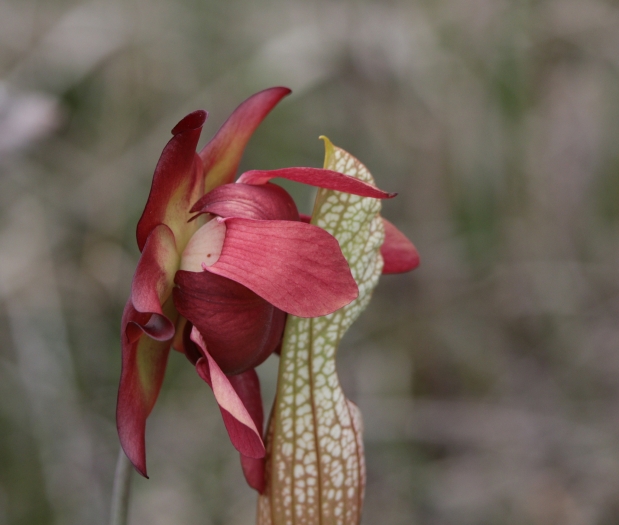Crimson Pitcherplant
(Sarracenia leucophylla)
Crimson Pitcherplant (Sarracenia leucophylla)
/
/

Kim
CC BY 4.0
Image By:
Kim
Recorded By:
Copyright:
CC BY 4.0
Copyright Notice:
Photo by: Kim | License Type: CC BY 4.0 | License URL: http://creativecommons.org/licenses/by/4.0/ | Rights Holder: Kim | Publisher: iNaturalist | Date Created: 2021-04-23T15:36:20-07:00 |
























































Estimated Native Range
Summary
Sarracenia leucophylla, commonly known as Crimson Pitcherplant, is a semi-deciduous perennial herb native to the Gulf Coast and southeastern United States, particularly thriving in wetlands such as bogs, marshes, and pine savannas. It is a distinctive carnivorous plant, capturing insects within its tubular leaves to supplement its nutrient intake in the nutrient-poor soils of its native habitat. The plant typically grows to a height of 18-36 inches (45-90 cm). The pitchers are most notable for their striking appearance: the upper portion is adorned with reddish-purple veins against a white background, creating a stark contrast, and is topped with an erect, roundish, wavy-edged hood to prevent rain from diluting the digestive enzymes inside.
The Crimson Pitcherplant is valued for its unique foliage and flowers, which add an exotic touch to gardens. It blooms in the spring with nodding, brownish-red flowers that, while not particularly showy, add to the plant’s intrigue. This species is often used in bog gardens, water features, and as a specimen in carnivorous plant collections. It requires full sun to part shade, consistently moist to wet soil with good drainage, and acidic conditions to thrive. While it is hardy to USDA zones 6 with winter protection, it is sensitive to stagnant water and can suffer from root rot if drainage is inadequate.CC BY-SA 4.0
The Crimson Pitcherplant is valued for its unique foliage and flowers, which add an exotic touch to gardens. It blooms in the spring with nodding, brownish-red flowers that, while not particularly showy, add to the plant’s intrigue. This species is often used in bog gardens, water features, and as a specimen in carnivorous plant collections. It requires full sun to part shade, consistently moist to wet soil with good drainage, and acidic conditions to thrive. While it is hardy to USDA zones 6 with winter protection, it is sensitive to stagnant water and can suffer from root rot if drainage is inadequate.CC BY-SA 4.0
Plant Description
- Plant Type: Herb
- Height: 1-3 feet
- Width: 1-3 feet
- Growth Rate: Rapid
- Flower Color: Purple, Red
- Flowering Season: Spring
- Leaf Retention: Semi-Deciduous
Growth Requirements
- Sun: Full Sun
- Water: High
- Drainage: Medium, Standing
Common Uses
Bee Garden, Bird Garden, Butterfly Garden, Fragrant, Hummingbird Garden, Potted Plant, Water Garden
Natural Habitat
Native to Gulf Coast wetlands, bogs, marshes, and pine savannas
Other Names
Common Names: White-Top Pitcherplant, Purple Trumpet-Leaf, White Pitcherplant
Scientific Names: , Sarracenia leucophylla, Sarracenia alba, Sarracenia drummondii, Sarracenia leucophylla f. viridescens, Sarracenia leucophylla var. alba, Sarracenia gronovii var. drummondii, Sarracenia drummondii var. alba, Sarracenia drummondii var. undulata, Sarracenia laciniata
GBIF Accepted Name: Sarracenia leucophylla Raf.